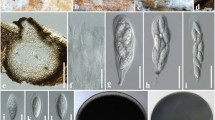Abstract
The red imported fire ant (RIFA) (Solenopsis invicta Buren), an exotic insect pest in Texas, has become well established throughout the eastern part of the state. More aggressive than native ant species, RIFA gradually have enlarged their range and spread north and west despite intense efforts to stop them. Symbiotic bacteria have an important relationship in the midgut of fourth instar RIFA larvae. However, the presence of symbiotic bacteria in hemolymph has not been explored. In this study, symbiotic bacteria isolated from the hemolymph of fourth instar larvae of RIFA were genetically identified in terms of genus using a partial sequence of the 16S rRNA gene. Using three different primer sets to amplify regions of the gyrA, gyrB, and SG850 genes, multiple species of the genus Bacillus were identified as inhabitants of fire ant hemolymph. Analysis of gyrA gene identified Bacillus cereus with a percentage match of 94.13–99.20% with DNA sequences from GenBank BLAST (www.ncbi.nih.gov). Using the gyrB gene, Bacillus species were identified with a percentage match of 95.48% to 100% using DNA sequences from GenBank. Finally, analysis of the SG850 gene identified Bacillus cereus with a percentage match of 96.20% to 99.83% using DNA sequences from GenBank.
Similar content being viewed by others
References
Bast DJ, Athamna A, Duncan CL et al (2004) Type II topoisomerase mutations in Bacillus anthracis associated with high-level fluoroquinolone resistance. J Antimicrob Chemother 54:90–94
Briano JA, Williams DF (2002) Natural occurrence and laboratory studies of the fire ant pathogen Vairimorpha invictae (Microsporida: Burenellidae) in Argentina. Environ Entomol 31:887–894
Daffonchio D, Borin S, Frova G et al (1999) A randomly amplified polymorphic DNA marker specific for the Bacillus cereus group is diagnostic for Bacillus anthracis. Appl Environ Microbiol 65:1298–1303
Davidson EW, Rosell RC, Hendrix DL (2000) Culturable bacteria associated with whitefly, Bemisia argentifolii (Homoptera: Aleyrodidae). Florida Entomol 82:159–171
Glancey BM, Vander Meer RK, Glover A et al (1981) Filtration of microparticles from liquid ingested by the red imported fire ant Solenopsis invicta Buren. Insectes Sociaux 28:395–401
Grisham J (1994) Attack of the fire ant. BioScience 44:587–590
Jouvenaz DP, Ellis EA (1986) Vairimorpha invictae n. sp. (Microspora: Microsporidia): a parasite of the red imported fire ant, Solenopsis invicta Buren (Hymenoptera: Formicidae). J Protozool 33:457–461
Knell JD, Allen GE, Hazard EI (1977) Light and electron microscope study of Thelohania solenopsae n. sp. (Microsporida; Protozoa) in the red imported fire ant, Solenopsis invicta. J Invertebr Pathol 29:192–200
Li HW, Medina F, Vinson SB, Coates CJ (2005) Isolation, characterization, and molecular identification of bacteria from the red imported fire ant (Solenopsis invicta) midgut. J Invertebr Pathol 89:203–209
Luxananil P, Atomi H, Panyim S, Imanaka T (2001) Isolation of bacterial strains colonizable in mosquito larvae as novel host cells for mosquito control. J Biosci Bioeng 92:342–345
Peloquin JJ, Greenberg L (2003) Identification of midgut bacteria from fourth instar red imported fire ant larvae, Solenopsis invicta Buren (Hymenoptera: Formicidae). J Urban Agricul Entomol 20:157–164
Slepecky RA, Hemphill HE (1992) The effects of environmental stress on bacteria. In: Balows A., Truper HG, Dworkin M et al (eds) Prokaryotes, 2nd edn, vol 2. Springer, New York, pp 1663–1696
Swiecicka I, Mahillon J (2006) Diversity of commensal Bacillus cereus sensu lato isolated from the common sow bug (Porcellio scaber, Isopoda). FEMS Micriobiol Ecol 56:132–140
Weisburg WGS, Barns M, Pelletier DA, Lane DJ (1991) Molecular cloning: a laboratory manual, 2nd edn. Cold Springs Laboratory, Cold Springs Harbor
Wilson NL, Dillier JH, Markin GP (1971) Foraging territories of red imported fire ants. Ann Ent Soc Am 64:660–665
Acknowledgments
We thank Dr. Darrell Pogue for his support of this project. This work was funded by a University of Texas at Tyler faculty research grant.
Author information
Authors and Affiliations
Corresponding author
Rights and permissions
About this article
Cite this article
Gunawan, S., Tufts, D.M. & Bextine, B.R. Molecular Identification of Hemolymph-Associated Symbiotic Bacteria in Red Imported Fire Ant Larvae. Curr Microbiol 57, 575–579 (2008). https://doi.org/10.1007/s00284-008-9245-2
Received:
Revised:
Accepted:
Published:
Issue Date:
DOI: https://doi.org/10.1007/s00284-008-9245-2




